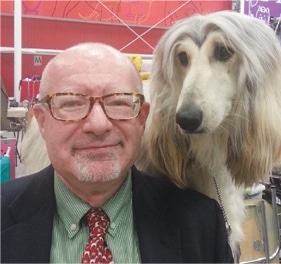Interview With Ed Thomason, Breeder of Alpine American Staffordshire Terriers, by Allan Reznik
Where did you grow up?
Ed Thomason: I was born and raised in Northern California. My wife Karen was born and raised in Washington state.
Do you come from a doggy family? And if not, how did the interest in breeding and showing purebred dogs begin?
Ed Thomason: Neither of us came from dog show or breeder families. Karen had a Smooth Dachshund growing up. My father had two American Staffordshire Terriers, and a Treeing Walker Coonhound that he used for boar hunting.
Who were your mentors in the sport? Please elaborate on their influence.
Ed Thomason: We have had many. I don’t think being mentored ever stops. Just this weekend I had the opportunity to watch a large entry of Field Spaniels with Andy Linton. I loved hearing how he saw the breed. But since I have to pick one, I would say Laurie Fenner. Her patience with me as a young man really drove me to be the dog handler I am today.
In Amstaffs, Chris Lee, Fred Sindelar, Margret Lyons and Lydia Castagna all really molded the two of us into what we are today. Each of them took time to work with us and teach us different things that we still use today. I got my first Amstaff from Chris. She helped fuel the fire for showing dogs. Fred taught Karen and me what correct type is in Amstaffs.
I would spend hours on the phone with him and listen to the same stories over and over again. I always seemed to pick up something new. Margret got Karen started in Amstaffs. She purchased her first few dogs from her and later went on to co-breed under the Timberland prefix before Karen and I got together. Lydia was one of the first people to hire me to show a special. We also went on to use one of her stud dogs to sire one of our first Alpine litters.
The Alpine Amstaffs are widely known, highly successful and well respected. What breeding philosophies do you adhere to?
Ed Thomason: Type, type, type. We work hard to produce a consistent type that is recognized anywhere in the world. Karen and I agree that when we consider a particular dog and bitch for a breeding, they must both meet at least two of the following three criteria: correct type for our breed, correct structure for our breed, and correct temperament for our breed. But it is type before all else. And it is important to mention that long before these criteria are discussed, the dogs must have passed all their health clearances.
How many dogs do you typically house, your own Amstaffs as well as the dogs you show for your clients? Tell us about your current facilities and how the dogs are maintained.
Ed Thomason: That number goes up and down. We are, first and foremost, a breeding kennel. We keep a good number of bitches and very few stud dogs. We believe you can purchase semen. If a male stays in our kennel, he has to be of the quality of a top-ranked terrier. Right now, we have two Amstaff males, Jelly and Pancho. We also have clients’ dogs with us. We almost always have a Tibetan Mastiff and several other terrier breeds living with us.
We have several outside covered runs and two run-out yards. The dogs are rotated between the house and yards throughout the day. In the evening, usually around 7 pm, they are crated in the kennel room for the night.
Who were/are some of your most significant dogs, both in the whelping box and in the show ring?
Ed Thomason: The best-producing Amstaff we have bred has to be Ch. Alpine’s Jamaica Me Crazy, “Vixen.” Every top dog we have ever produced goes back to her. Other notable sires would be Ch. Alpine’s Rio Grande, GCh. Alpine’s Ring Of Fire and, of course, GCh. Alpine’s Highwayman. Our current special “Pancho” is blazing a path for the breed. In a very short 18 months he has amassed 107 Group wins, 27 Best in Shows and 28 Reserve Best in Shows. As a young dog he was awarded the coveted honor of Best Bred-by-Exhibitor in Show at Montgomery County, as well as winning the Bullyganza competition held at the Santa Barbara Kennel Club.
Please comment positively on your breed’s present condition and what trends might bear watching.
Ed Thomason: All breeds have their ups and downs. I think our breed is in decent shape. I always remind judges, when educating them on our breed, that Amstaffs should have a slightly sloping topline from withers to rump, with a slight fall off at the croup. We DON’T want a “table top” Working dog type topline.
I would also mention that this is not a breed to be raced around the ring at Sporting Dog speed. The Amstaff should keep the same shape on the move that it
does standing.
The sport has probably changed a lot since you first began participating. Speaking as both a breeder-exhibitor and a professional handler, what are your thoughts on the state of the fancy and the declining number of breeders? How do we encourage newcomers to join us and remain in the sport?
Ed Thomason: Being a breeder today is tough. You see the push for people to “rescue” dogs rather than purchase a reliable companion from a reputable breeder. While social media can certainly play a positive role in purebred dogs and our lives, it also seems to encourage fighting and squabbling among some. So between the fighting and the pressure from various groups it has become difficult to breed dogs and place them. This, in my opinion, has weeded out many breeders so that today, we generally have only the very passionate folks left.
Still, Karen and I have done a good job of using social media to our advantage. We started a Facebook page, “Alpine Amstaffs,” which now has more than 30K followers. We post show wins, fun photos of the dogs and lots of shots of puppies playing. This has brought positive attention not just to our breeding program but also to our breed. We also have a closed Facebook group called “Alpine Amstaffs Family and Friends,” for folks who have purchased a dog from us. We have created a community of people who often share their pet photos with one another. It has also sparked interest among owners of Alpine dogs to do more with their dogs, like Fast CAT events.
If I could give anyone some advice it would be: Be nice to new people and most important, be encouraging to the juniors who are coming into the sport. I believe we must take a more active role in our local 4-H programs. If we can turn these folks into breeders and supporters of purebred dogs, we will start to grow our young base again.
Where do you see your breeding program in the next decade or two?
Ed Thomason: We have big plans still. Karen and I are very goal oriented. We will continue to strive for correct type, and to produce dogs that are not only competitive in the show ring but in performance events as well. Our dream is to breed and handle a dog that becomes America’s Top Terrier. To the best of our knowledge, this has never been done before in a “bully” breed. We have been blessed to have multiple Top 5 terriers and even hold the ranking of Top Terrier and Top Dog in America for a short period of time. In order to achieve a goal you must do much more than dream. So we will continue to work on our plans to achieve this. We are young and our breed is winning more than it ever has so we are getting close.
Finally, tell us a little about Ed and Karen outside of dogs…your professions, your hobbies.
Ed Thomason: Karen works at a local vet clinic and loves the outdoors and hiking. She usually does those activities with an Amstaff or two. Besides being a professional handler, I work for Impact Dog Crates. I love cars and car shows. I also enjoy studying the real estate market. But our favorite pastime is to sit on our deck with our close friends and family and enjoy a nice dinner.









